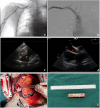Migration of covered stents in thoracic central vein obstruction procedures in patients with hemodialysis: Case report and literature review
- PMID: 35966538
- PMCID: PMC9363624
- DOI: 10.3389/fcvm.2022.954443
Migration of covered stents in thoracic central vein obstruction procedures in patients with hemodialysis: Case report and literature review
Abstract
Objective: The objective of the study is to present a case of hemodialysis in which the covered stent that had migrated into the right ventricle was retrieved by exploratory thoracotomy, and to review the literature on the diagnosis and treatment of stent migration in thoracic central vein obstruction (TCVO) procedures for hemodialysis patients.
Method: A systematic search of the PubMed database was performed to identify clinical presentations, imaging strategies, stent types, and treatment modalities for stent migration in hemodialysis patients.
Results: A total of 14 case reports on stent migration in TCVO procedures for hemodialysis patients were included and analyzed. Ten cases included migration to the cardiac chambers and the remainder migration to the pulmonary artery. The common symptoms of stent migration in TCVO procedures are reported to be chest pain and dyspnea, while three of the cases studied involved no symptoms. Echocardiography, chest X-ray, and computed tomography are the commonly used methods for the diagnosis of stent migration and identification of the precise positioning of the stent. Stent migration to the right subclavian or innominate veins was the most prevalent case (seven cases). All were bare stents. Seven cases involved retrieval by interventional surgery, while four cases involved retrieval by open heart surgery. However, there were three cases in which the "wait-and-see" approach was adopted since the patients were asymptomatic.
Conclusions: Stent migration in TCVO procedures is a rare but extremely serious complication. The causes are not fully understood. The current treatment strategies include interventional surgery, open heart surgery, and the "wait-and-see" approach.
Keywords: hemodialysis; literature review; stent displacement; stent migration; thoracic central vein obstruction.
Copyright © 2022 Chen, Lai, Fedally and Wan.
Conflict of interest statement
The authors declare that the research was conducted in the absence of any commercial or financial relationships that could be construed as a potential conflict of interest.
Figures

Similar articles
-
Endovascular treatment of type 3 and 4 thoracic central vein obstruction in hemodialysis patients.J Vasc Surg Venous Lymphat Disord. 2021 May;9(3):643-651.e3. doi: 10.1016/j.jvsv.2020.10.009. Epub 2020 Oct 20. J Vasc Surg Venous Lymphat Disord. 2021. PMID: 33096274
-
A review of the incidence, outcome, and management of venous stent migration.J Vasc Surg Venous Lymphat Disord. 2022 Mar;10(2):482-490. doi: 10.1016/j.jvsv.2021.07.015. Epub 2022 Jan 11. J Vasc Surg Venous Lymphat Disord. 2022. PMID: 35026448
-
Mid-term Results of a Novel Dedicated Venous Stent for the Treatment of Chronic Thoracic Central Vein Obstruction of Benign Aetiology.Eur J Vasc Endovasc Surg. 2019 Mar;57(3):417-423. doi: 10.1016/j.ejvs.2018.10.009. Epub 2018 Nov 4. Eur J Vasc Endovasc Surg. 2019. PMID: 30404722
-
Venous stent versus conventional stent for the treatment of central vein obstruction in hemodialysis patients: a retrospective study.Acta Radiol. 2022 Jan;63(1):59-66. doi: 10.1177/02841851211005163. Epub 2021 Mar 27. Acta Radiol. 2022. PMID: 33779305
-
Infections of intravascular bare metal stents: a case report and review of literature.Eur J Vasc Endovasc Surg. 2014 Jan;47(1):87-99. doi: 10.1016/j.ejvs.2013.10.006. Epub 2013 Oct 22. Eur J Vasc Endovasc Surg. 2014. PMID: 24239103 Review.
Cited by
-
U-bent Viabahn stent graft in the main left pulmonary artery in a hemodialysis patient after asymptomatic migration: Percutaneous removal and technical considerations.J Vasc Access. 2024 Sep;25(5):1666-1671. doi: 10.1177/11297298231158545. Epub 2023 Jul 13. J Vasc Access. 2024. PMID: 37439244 Free PMC article.
-
Migration of central vein stent into the right atrium.Korean J Intern Med. 2024 Mar;39(2):364-365. doi: 10.3904/kjim.2023.282. Epub 2023 Nov 10. Korean J Intern Med. 2024. PMID: 37946450 Free PMC article. No abstract available.
References
Publication types
LinkOut - more resources
Full Text Sources

